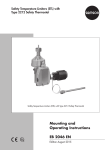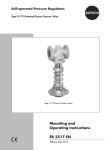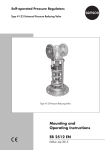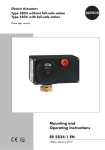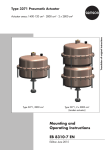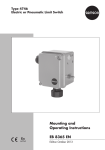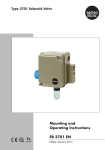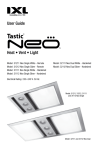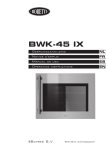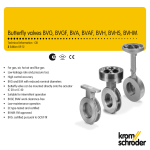Download Mounting and Operating Instructions EB 3134 EN
Transcript
Self-operated Regulators Type 46-5 N Differential Pressure and Flow Limiter Type 46-5 N Mounting and Operating Instructions EB 3134 EN Edition August 2015 Definition of signal words DANGER! Hazardous situations which, if not avoided, will result in death or serious injury WARNING! Hazardous situations which, if not avoided, could result in death or serious injury 2 NOTICE Property damage message or malfunction Note: Additional information Tip: Recommended action EB 3134 EN Contents 1 General safety instructions..............................................................................4 2 Process medium and scope of application........................................................5 3 Transportation and storage.............................................................................5 4 Design and principle of operation...................................................................5 5 Installation.....................................................................................................7 1.1 Mounting position...........................................................................................7 1.2 Strainer (filter)................................................................................................8 1.3 Shut-off valve..................................................................................................8 1.4 Pressure gauge...............................................................................................8 1.5 Control line....................................................................................................8 6 Operation......................................................................................................9 1.1Start-up..........................................................................................................9 1.2 Adjusting the set point.....................................................................................9 1.3Decommissioning............................................................................................9 1.4 Sample application.......................................................................................10 7 Maintenance and troubleshooting.................................................................12 8 Nameplate...................................................................................................12 9 Service........................................................................................................13 10 Dimensions and weights...............................................................................14 11 Technical data..............................................................................................15 EB 3134 EN 3 General safety instructions 1 General safety instructions −− All safety instructions and warnings given in these mounting and operating instructions, particularly those concerning installation, start-up and maintenance, must be strictly observed. −− The device must be mounted, started up or serviced by fully trained and qualified personnel only; the accepted industry codes and practices are to be observed. Make sure employees or third persons are not exposed to any danger. −− According to these mounting and operating instructions, trained personnel refers to individuals who are able to judge the work they are assigned to and recognize possible dangers due to their specialized training, their knowledge and experience as well as their knowledge of the applicable standards. −− The devices comply with the requirements of the European Pressure Equipment Directive 2014/68/EU. Devices with a CE marking have a declaration of conformity, which includes information about the applied conformity assessment procedure. This declaration of conformity can be provided on request. −− To ensure appropriate use, only use the device in applications where the operating pressure and temperatures do not exceed the specifications used for sizing the device at the ordering stage. −− The manufacturer does not assume any responsibility for damage caused by external forces or any other external factors. −− Any hazards that could be caused in the regulator by the process medium, operating pressure or by moving parts are to be prevented by taking appropriate precautions. −− Proper transport, storage, installation, operation and maintenance are assumed. 4 Note: Non-electric valve versions whose bodies are not lined with an insulating material coating do not have their own potential ignition source according to the risk assessment stipulated in EN 13463-1: 2009, section 5.2, even in the rare incident of an operating fault. Therefore, such valve versions do not fall within the scope of Directive 94/9/EC. For connection to the equipotential bonding system, observe the requirements specified in section 6.3 of EN 60079-14: 2011 (VDE 0165 Part 1). EB 3134 EN Process medium and scope of application 2 Process medium and scope of application Differential pressure and flow limiter for local heat supplies and large heating networks · Flow rate set points from 0.1 to 1 m³/h · Differential pressure set points 0.2 bar, 0.3 bar or 0.5 bar · Nominal pressure PN 10 · Nominal size DN 15 · Suitable for treated water up to 110 °C and non-flammable gases up to 80 °C The valve closes when the differential pressure exceeds the adjusted set point. The flow rate is limited. 3 Transportation and storage The regulator must be carefully handled, transported and stored. Protect the regulator against adverse influences, such as dirt, moisture or frost, during storage and transportation. 4 Design and principle of operation See Fig. 1 on page 6. The regulator basically consists of a valve body (1) with restriction (11), seat (2) and plug (3) as well as a closing actuator with an operating diaphragm (9). The regulator is designed to limit the differential pressure to a fixed value (0.2, 0.3 or 0.5 bar) and the flow rate to the adjusted set point in local heat supply networks and heating systems. EB 3134 EN 5 Design and principle of operation The medium flows through the valve in the direction indicated by the arrow on the valve body. The flow rate is determined by the area released by the valve plug (3) and the adjustable restriction (11). The high pressure upstream of the restriction is transmitted to the high-pressure side of the actuator through the control line (7) attached on installing the regulator. The low pressure downstream of the restriction acts on the low-pressure side (10) of the operating diaphragm (9) through a hole in the valve plug. The differential pressure generated at the restriction is converted into a positioning force by the operating diaphragm. If this force exceeds the force of the installed set point spring (5), the valve closes. In the same manner, the valve opens if the positioning force falls below the spring force. The flow rate is restricted by turning the set point screw to change the flow cross-section at the restriction. 13 12 1 11 2 3 1 2 3 4 5 6 7 8 9 10 11 12 13 14 Valve body Seat Plug Plug stem with hole 10 Set point spring Actuator 9 High-pressure control line High-pressure side Operating diaphragm Low-pressure side 8 Set point screw (restriction) Turned into the Lock nut plane of projection Cap 7 Angular screw joint 4 5 6 14 Fig. 1: Functional diagram of Type 46-5 N 6 EB 3134 EN Installation 5 Installation 5.1 Mounting position See Fig. 1 on page 6. The regulators are installed in the low-pressure line. This line is always the return flow pipe in local heat networks. Standard installation · Install the regulators in horizontal pipelines with the actuator facing down. −− Install a strainer (e.g. SAMSON Type 1 NI) upstream of the regulator (see section 5.2). −− The direction of flow must match the direction indicated by the arrow on the body. −− Connect external control lines at the side of the main pipe. Use the supplied angular screw joint to connect it to the regulator (see section 5.5). NOTICE Incorrectly installed regulator The regulator can be damaged. Make sure the regulator is installed free of stress. Observe permissible mounting position. The following generally applies: −− Choose a place of installation that allows you to freely access the regulator even after the entire plant has been completed. Flow pipe Return flow pipe – + Fig. 2: Sample application (schematic) EB 3134 EN 7 Installation 5.2 Strainer (filter) 5.5 Control line A strainer installed upstream in the flow pipe holds back any dirt or other foreign particles. For example, the SAMSON Type 1 NI Strainer is suitable (u T 1010). A control line with 6 mm pipe diameter must be adapted and mounted on site. Route the control line as indicated in Fig. 2. −− Install the strainer upstream of the regulator. −− The direction of flow must correspond to the arrow on the body. −− The filter element must be installed to hang downwards. −− Remember to leave enough space to remove the filter element. 5.3 Shut-off valve An angular screw joint (14) for connecting the control line to the actuator (6) is supplied with the regulator. ÎÎ To mount the control line, screw the screw joint clockwise () into the intended hole on the high-pressure side (8) and align it. Note: Do not turn the screw joint back again. Otherwise, the connection may start to leak. Install a hand-operated shut-off valve both upstream of the strainer and at the outlet of the return flow pipe. This allows the plant to be shut down for cleaning and maintenance, and when the plant is not used for longer periods of time. 5.4 Pressure gauge Install a pressure gauge at a suitable point to monitor the pressures prevailing in the plant. 8 EB 3134 EN Operation 6 Operation See Fig. 1 on page 6. 6.1 Start-up ÎÎ First start up the regulator after mounting all parts. ÎÎ Make sure the control line is open and correctly connected. ÎÎ Open all the consumers in the plant (minimum drag in the plant) to achieve maximum flow rate. Note: On filling the plant, make sure the restriction is open by turning the set point screw (11) counterclockwise () as far as it will go. Rinsing the plant · After filling the plant, first completely open the consumers. Set the maximum flow cross-section (by turning the set point screw counterclockwise () as far as it will go). Rinse out the pipeline at full flow rate for several minutes. Check the installed strainer (e.g. by measuring the pressure drop). Clean the strainer, if necessary. EB 3134 EN 6.2 Adjusting the set point If a bypass is installed in the plant, it must be closed. Note: Set point adjustment is always based on a closed restriction (11). 1. Unscrew the cap (13). 2. Undo the lock nut (12) and turn the set point screw (11) using a 4 mm Allen key. ÎÎ Turn clockwise : The restriction closes. The flow rate drops. ÎÎ Turn counterclockwise : The restriction opens. The flow rate rises. Use the diagram in Fig. 3 as a guide for adjustment. 3. After adjustment, screw tight the lock nut and screw back on the cap (13). 6.3 Decommissioning Preferably close first the shut-off valve on the upstream side of the valve and then on the downstream side of the valve. 9 Operation 6.4 Sample application Adjusting the flow limitation (medium: water) when the pressure loss across the plant is known. Note: Set point adjustment is always based on a closed restriction (11). Known: −− A Type 46-5 N, KVS = 1.0, flow rate range from 0.12 to 0.5 m³/h is to be used to limit the flow rate in the plant to 0.3 m³/h. −− The pressure drop across the plant (Δpplant) is 0.15 bar. −− The differential pressure set point is 0.3 bar. −− Determine the adjustment values using the adjustment diagram in Fig. 3. To be determined: How many turns of the set point screw are necessary to limit the flow rate? 10 Solution: Sequence: points A to E in diagram (Fig. 3). The calculation is based on the pressure drop Δp in the plant, therefore, this value must be known. Δp = 0.15 bar is specified in the example and corresponds with point A in the diagram. The differential pressure at the restriction (Δprestriction) assumed to be 0.15 bar in the example, must be added up to the line of the differential pressure set point of 0.3 bar. A line representing this value is drawn from A across to the right and results in point B. A vertical line is drawn from point B until it reaches the limiting curve for the flow rate (in the example, it is 0.3 m³/h). This is point C. The horizontal line is drawn from point C across to the curve relevant for KVS = 1.0; this is point D. When a line is drawn vertically upwards from point D, this results in point E which indicates how many turns of the set point screw are required. The example shows that around 4 turns are required. Based on a closed restriction, turn the set point screw (11) approximately four turns counterclockwise to open the restriction. EB 3134 EN Operation Pressure loss across the plant Δpplant in bar 0.6 Fixed differential pressure set point 0.5 0.4 0.3 5 4 3 2 E V˚ [m3/h] 0.06 0.18 0.30 0.42 0.54 C D 0.66 0.78 0.90 Kvs 1.0 Adjustment diagram for water 6 B 3 0. 7 5 0. Turns of the set point screw 0.2 A 1 0.1 1.02 1.14 Kvs 2.5 Flow rate ranges Possible range 0.2 0.4 Differential pressure at the restriction Δprestriction in bar Fig. 3: Adjustment diagram for flow limitation EB 3134 EN 11 Maintenance and troubleshooting 7 Maintenance and troubleshooting WARNING! Before performing any work on the regulator, make sure the relevant plant section has been depressurized and, depending on the process medium, drained as well. We recommend removing the valve from the pipeline. When used at high temperatures, allow the plant section to cool down to ambient temperature. Disconnect or shut off the control line to prevent the risk of moving regulator parts. As valves are not free of cavities, remember that residual process medium might still be contained in the valve. The regulator does not require any maintenance. Nevertheless, it is subject to natural wear, particularly at the seat, plug and operating diaphragm. If the flow rates deviates considerably from the set point, first check the control line for blockage. Furthermore, the seat and plug may leak due to dirt particles or natural wear. Therefore, check the regulator and replace it, if necessary. Depending on the operating conditions, check the regulator at regular intervals to avoid possible malfunctions. The SAMSON After-sales Service department provides support for maintenance and inspection work (see section 9). 8 Nameplate 1 3 2 4 1 Configuration ID (Var.-ID) 2 Type designation 3 Model number 4 Date of manufacture In the other fields: KVS or CV coefficient Max. permissible temperature in °C or °F Differential pressure set point range in bar or psi Flow rate set point range in m³/h Max. perm. differential pressure Δp Fig. 4: Nameplate 12 Nominal pressure PN or ANSI Class EB 3134 EN Service 9 Service Contact SAMSON's After-sales Service department for support concerning maintenance or repair work or when malfunctions or defects arise. E-mail: [email protected] Addresses of SAMSON AG and its subsidiaries The addresses of SAMSON AG, its subsidiaries, representatives and service facilities worldwide can be found on the SAMSON website (u www.samson.de) in all SAMSON product catalogs or on the back of these Mounting and Operating Instructions. To assist diagnosis and in case of an unclear mounting situation, specify the following details: −− Device type and nominal size −− Model number or configuration ID (Var.-ID) on the nameplate −− Upstream and downstream pressure −− Temperature and process medium −− Min. and max. flow rate in m³/h −− Is a strainer installed? −− Installation drawing showing the exact location of the regulator and all the additionally installed components (shut-off valves, pressure gauge, etc.) Note: Conversion from chromate coating to iridescent passivation We at SAMSON are converting the surface treatment of passivated steel parts in our production. As a result, you may receive a device assembled from parts that have been subjected to different surface treatment methods. This means that the surfaces of some parts show different reflections. Parts can have an iridescent yellow or silver color. This has no effect on corrosion protection. For further information go to u www.samson.de/chrome-en.html EB 3134 EN 13 Dimensions and weights 10Dimensions and weights 65 65 Type 46-5 N Weight without accessories, approx. 0.85 kg ~65 ISO 228/1-G ¾ B Ø95 210 G½ Ø21.3 129 SW30 With threaded ends SW30 With welding ends Fig. 5: Dimensional drawings 14 EB 3134 EN Technical data 11Technical data Nominal size Connection Type of connection KVS coefficient Standard version Special version Nominal pressure Max. perm. differential pressure Δp Max. permissible temperature Treated water Non-flammable gases xFZ value Flow rate set point range for water with a differential pressure at restriction of 0.2 bar Standard version Special version Differential pressure set point 1), optionally Compliance 1) DN 15 ISO 228/1-G ¾ B Threaded ends G ½ · Welding ends 2.5 1.0 PN 10 4 bar 110 °C 80 °C 0.43 0.2 to 1 m³/h 0.12 to 0.5 m³/h 0.2 · 0.3 · 0.5 bar · To achieve the maximum flow rate, the differential pressure set point must be at least 0.2 bar higher than that of the plant. Pressure conditions in the plant and at the regulator On selecting the differential pressure set point Δpset point, note that the differential pressure set point results from the known pressure drop across the fully open plant and the differential pressure created at the restriction. Δpset point = Δpplant + ∆prestriction To achieve the maximum flow rate, the differential pressure set point must be at least 0.2 bar higher than that of the plant. If the differential pressure set point is only 0.1 bar higher than the pressure drop across the fully open plant, the maximum flow rate is reduced to 0.7 m³/h. The minimum required differential pressure Δpmin across the valve is calculated as follows: Δpmin = Δpset point + ( V· KVS ) 2 Δpmin Minimum differential pressure between flow and return pipes in bar Δprestriction Differential pressure created at restriction for measuring the flow rate Δpset point Differential pressure set point in bar Δpplant · EB 3134 EN Differential pressure (pressure loss) when the plant is completely open in bar V Adjusted flow rate in m³/h KVS Valve flow coefficient in m³/h 15 Weismüllerstraße 3 · 60314 Frankfurt am Main, Germany Phone: +49 69 4009-0 · Fax: +49 69 4009-1507 [email protected] · www.samson.de EB 3134 EN 2015-08-28 · English SAMSON AG · MESS- UND REGELTECHNIK
















